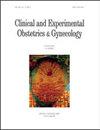Efficacy and Safety of PD-1/PD-L1 Inhibitors in Neoadjuvant Chemotherapy for Triple-Negative Breast Cancer: A Systematic Review and Meta-Analysis
IF 0.6
4区 医学
Q4 OBSTETRICS & GYNECOLOGY
引用次数: 0
Abstract
Background: Compared with other subtypes, triple-negative breast cancer (TNBC) is more aggressive and has a lower survival rate with chemotherapy being the only acknowledged systemic treatment option. Recently, PD-1/PD-L1 (programmed cell death-1 and programmed death-ligand 1) inhibitors have demonstrated survival benefits in locally advanced or metastatic TNBC patients. However, the effects of PD-1/PD-L1 inhibitors in neoadjuvant chemotherapy remain controversial. Methods: Extensive literature searches were conducted in the PubMed, Embase and Cochrane databases. A pooled odds ratio (OR) with 95% confidence intervals (CI) was analyzed. Results: Seven randomized controlled trials (N = 1707) were included. PD-1/PD-L1 inhibitor chemotherapy group showed pathological complete response (pCR) benefit of 59.0% vs. 40.4% (OR 1.98, 95% CI 1.38–2.82, p < 0.001). Hematological adverse events were similar. There was no significant difference between the two groups in terms of anemia (OR 1.25, 95% CI 0.93–1.68, p = 0.14; I2 = 0%, p = 0.99) or neutropenia (OR 1.00, 95% CI 0.82–1.21, p = 0.96; I2 = 0%, p = 0.70). Conclusions: Adding PD-1/PD-L1 inhibitors to neoadjuvant chemotherapy can improve pCR rates in TNBC patients without increasing hematological toxicities. The data suggests that PD-1/PD-L1 inhibitors may be a viable option for patients with TNBC.PD-1/PD-L1抑制剂在三阴性乳腺癌新辅助化疗中的疗效和安全性:一项系统综述和荟萃分析
背景:与其他亚型相比,三阴性乳腺癌(TNBC)更具侵袭性,生存率较低,化疗是唯一公认的全身治疗选择。最近,PD-1/PD-L1(程序性细胞死亡-1和程序性死亡配体1)抑制剂在局部晚期或转移性TNBC患者中显示出生存益处。然而,PD-1/PD-L1抑制剂在新辅助化疗中的作用仍然存在争议。方法:在PubMed、Embase和Cochrane数据库中进行广泛的文献检索。分析合并优势比(OR)和95%置信区间(CI)。结果:纳入7项随机对照试验(N = 1707)。PD-1/PD-L1抑制剂化疗组病理完全缓解(pCR)获益为59.0% vs 40.4% (OR 1.98, 95% CI 1.38-2.82, p <0.001)。血液学不良事件相似。两组在贫血方面无显著差异(OR 1.25, 95% CI 0.93-1.68, p = 0.14;I2 = 0%, p = 0.99)或中性粒细胞减少症(or 1.00, 95% CI 0.82-1.21, p = 0.96;I2 = 0%, p = 0.70)。结论:在新辅助化疗中加入PD-1/PD-L1抑制剂可提高TNBC患者的pCR率,且不会增加血液毒性。数据表明,PD-1/PD-L1抑制剂可能是TNBC患者的可行选择。
本文章由计算机程序翻译,如有差异,请以英文原文为准。
求助全文
约1分钟内获得全文
求助全文
来源期刊
CiteScore
0.50
自引率
0.00%
发文量
241
审稿时长
1 months
期刊介绍:
CEOG is an international, peer-reviewed, open access journal. CEOG covers all aspects of Obstetrics and Gynecology, including obstetrics, prenatal diagnosis, maternal-fetal medicine, perinatology, general gynecology, gynecologic oncology, uro-gynecology, reproductive medicine, infertility, reproductive endocrinology, sexual medicine. All submissions of cutting-edge advances of medical research in the area of women''s health worldwide are encouraged.

 求助内容:
求助内容: 应助结果提醒方式:
应助结果提醒方式:


